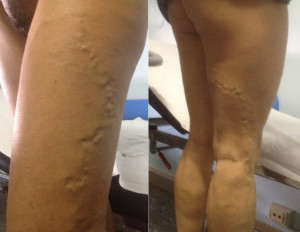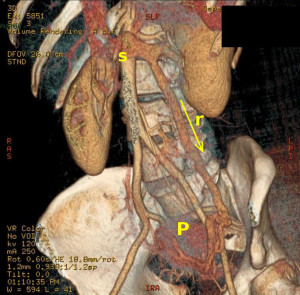Pelvic congestion syndrome (PCS) can be defined as a prolonged pressurisation of the venous networks of the pelvis. The condition occurs predominantly in women, especially after childbirth. However, men can be affected because there is debate as to whether PCS is a significant contributor to haemorrhoidal disease. The haemodynamic pathophysiology includes obstruction or reflux of the venous drainage pathways or a combination of both. Typically, pelvic symptoms present to the gynaecologist with leg symptoms to the vascular surgeon, phlebologist or dermatologist. A multidisciplinary treatment approach is required if both pelvic and leg symptoms are concurrent.
SERGIO PILLON Pelvic varices are a common cause of recurrence in the surgical treatment of venous reflux disease and varicose veins in the leg. For this reason their presence should be suspected in any female following childbirth, especially if the varicose veins are atypical in their distribution. Inguinal, vulval, pudendal or perineal varicosities are often diagnostic of pelvic venous reflux (PVR). They are also the main cause of distal great saphenous vein (GSV) reflux in the presence of a competent terminal valve. Concurrent pelvic pain is highly suggestive of PCS.
Not all varicose veins from PCS are primary. The Nutcracker syndrome from compression of the left renal vein between the aorta and superior mesenteric artery results in reflux down the ovarian veins as a main drainage collateral from the kidney. Compression of the left common iliac vein by the overlying right common iliac artery in the May-Thurner syndrome likewise can precipitate PVR.
A trans-vaginal ultrasound (TVR) examination will help in the diagnosis of pelvic varices and may help in defining the cause of PVR. This should be combined with an abdominal ultrasound. Ovarian vein calibre, high flow ovarian reflux velocity and reverse flow in the internal iliac vein may lead to a diagnosis before the more confirmatory invasive investigations.
Trans-catheter retrograde foam sclerotherapy of pelvic varices from ovarian and internal iliac origin is a safe and effective technique in lower extremity venous insufficiency treatment. It must always be considered in female patients with recurrent superficial varicosities of the lower limbs with competent proximal valves of the GSV.
Patient after trans-catheter retrograde foam sclerotherapy of pelvic varices. Successful closure of the perineal leak points are demonstrated by the appearance of “negative” veins on the leg.
Nutcracker syndrome with pelvic varices. Stenosis (s) of the left renal vein has resulted in reflux (r) down the ovarian vein which is supplying the pelvic varices (P).

